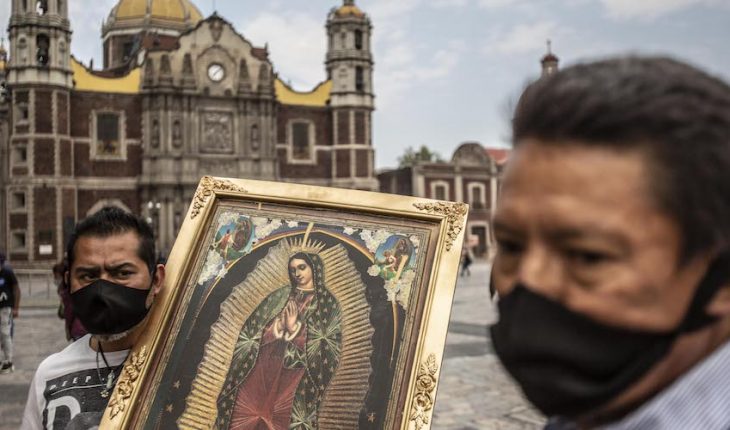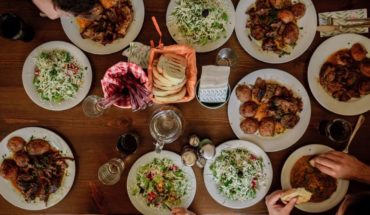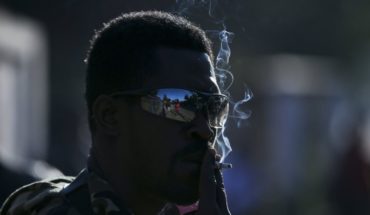Juan Carlos Cortés, merchant of Chalco, State of Mexico, 45, knows well the effects of COVID-19. His brother Alberto, four years his eldest, “was about to die because he was not received in any hospital.”
“Blessed be God, he delivered her, but he was admitted to Nutrition for a month,” he explained. To thank that healing, Cortés perished to the Basilica of Guadalupe carrying a huge image of the virgin, the same one that for 10 years has carried to the church.
For the first time since Cortés walks to the temple everything is different. No crowds, no uncontrolled fervor. It’s like a miniature rehearsal with a healthy distance.
Read more: Basilica of Guadalupe will close from December 10th to 13th to avoid crowds
The pandemic forced the closure of the shrine, which will be closed from Thursday, November 10, to avoid crowds. For the pilgrim, the announcement of the closure did not prevent him from complying with religious tradition: he was one of the thousands who advanced his visit to the Basilica to avoid encountering the closed doors. However, nothing was the same.
“He’s kind of rough. News indicates that you don’t have to come, that it’s bad to fill up that day (with) everyone. But it’s a tradition that Mexicans have very ingrained. We can’t stop coming to ask our mother,” she said newly arrived on the temple esplanade, with her image in tow.
Along with him, another partner of Chalco who claimed to have made the same journey in the last 35 years. “Faith is greater than all obstacles. This drives us too much. This is a tradition rooted from our great-grandparents,” he said.
Photos: Carlo Echegoyen (@CarloEchegoyen)
Latin America’s largest pilgrimage was reduced to a few thousand faithful who advanced the journey and foresight that, when the perimeter is closed, some believers still arrive with their images of the Guadalupana in tow.
Nothing to do with the more than two million people who paraded around this same place on December 12, 2019, nor with the 10 million who visited the Basilica the first two weeks of December last year.
Keeping a healthy distance is not complicated in the immense esplanade that opens before the temple. Those who attend Mass, a handful, can keep a row and the meter and a half away without complications. If it was three meters, the regulators wouldn’t have any room either.
In a context where the authorities have urged the population to stay home, that few thousands of people come to venerate the virgin is almost a miracle. There is more agglomeration per square meter in some streets of downtown Mexico City.
“We’re afraid of everything, but we do it this way. Respecting security measures, anything can be done,” Cortés said. His companion, who has not been hit by the coronavirus among his close friends, added: “I’m here to thank you that we’re all fine. And may the virgin intercede for us before God and let us continue to survive, for we do not live, we survive.”
To enter the esplanade of the Basilica, Cortés and his companion had to go through the health filters installed by Mexico City. First, the antibacterial gel. Then pass behind the chambers that determine if the pilgrim is more than 37 degrees. By 14 hours, about 14,000 people had passed through one of the three gates. Of these, just over a thousand exceeded the required temperature. The vast majority, however, were due to heat and dehydration and after a few minutes of rest could enter without problems. At the end of the day, 35,794 people went through the various filters.
Three days of walking and returning to Puebla
“This is the only day you can come to congratulate her, to venerate her, to thank her for the wonderfulness of life and to ask her to help us with the damn pandemic that is sweeping humanity. If you listen to me and listen to everyone, maybe it’s over sooner,” said Mario Poblano Velázquez, 55.
Gone are almost four days of walking since he left Puebla, carrying another of those huge images that can only be carried on his back.
“I fulfilled my faith, with my congratulations, I came on foot to visit the boss,” said the man, a welder by profession and who has not missed the appointment with the Virgin Brunette for 35 years. A year ago, he recognized, he arrived to fulfill the pilgrimage on the same 12, but now he did not want to play it. “It is sad to see all this empty, but it is for the good of all, and we must accept the rules in life. At some point there will come a better time,” he said.
He assured that, in his case, he was not afraid to catch it. “I don’t think anything will happen and if it happens, or mode, we’re all exposed.”
For Rodolfo Alonso, 65, the danger is greater, to findto be among the at-risk population. However, he moved from Ahuehuetzingo, Puebla, to the Basilica, to bring the fire of the candles from the temple to the homes of his municipality.
“Every year we run in and at every home we greet, offering each family. They welcome us with rockets, music, food. It’s very nice,” he explained.
He, who has been leading a group of 50 neighbors on the pilgrimage for at least seven years, decided that tradition would be done in the only way possible: with a single envoy to collect the fire and take it to his community.
After leaving the temple, with the flame already on, Alonso acknowledged that “this gives sadness. We’re watching the pandemic affect us worldwide. A lot of people had our pilgrimage planned, but everything fell apart,” said the retired man, who previously served as a military man.
Taking advantage of the becoming the emissary of Ahuehuetzingo before the Virgin Brunette, man took the opportunity to express the desire in the mouth of all pilgrims: “We ask Our Lady to soon finish this”.
Businesses with big losses
For believers, a year of losing tradition is a blow. For traders who live from the crowd visits, the suspension of the celebrations is a devastating blow. The losses are large and now they think about how they will survive for a whole year without the economic injection that these weeks entails.
“We can’t close. Even if the Basilica is closed a little people will come, though not like other years,” said Irma Nicolasa, a shop that offers all kinds of religious memories.
Before, he explained, this whole street would be full of customers, with tents to sleep the pilgrims and thousands of people parading in front of the window. “Sales have dropped by about 80%,” he acknowledged.
The most serious thing will come later. The woman says that during these days the forecasts were made for the rest of the year. “Sales start in October, but these are the strongest days. But now there’s nothing, no tourists, no nationals,” he explained.
She, who has to be in spite of everything in front of the public, acknowledged that fear of contagion exists. But he “takes action.”
Find out: These Metro stations will be closed during the days of celebration of the Virgin of Guadalupe
In all the surrounding streets, the same laments are heard: the sales drop is unsustainable but there is no aid for the sector either. “Sales went down too low, if you used to sell 10 grand now a thousand,” said Francis, a shopkeeper at the doorstep of his business of paintings and religious books. “Today was expected to be the good day, but no, ” he lamented.
There was concern that agglomerations were a focus of contagion for the coming days in Mexico City. Even Pope Francis, from the Vatican, offered indulgence to believers who celebrate the Virgin Brunette from their homes.
At eight o’clock on Thursday afternoon, the doors of the Basilica will be closed for good. To avoid the temptation of those who are more blind than feared by COVID-19, the capital government will close the perimeter, as it has already done with Via crucis de Iztapalapa at Easter.
What we do at Animal Politics requires professional journalists, teamwork, dialogue with readers and something very important: independence. You can help us keep going. Be part of the team.
Subscribe to Animal Politics, receive benefits and support free journalism.#YoSoyAnimal





